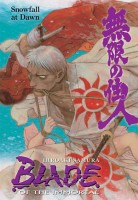 Creator: Hiroaki Samura
Creator: Hiroaki Samura
U.S. publisher: Dark Horse
ISBN: 9781616552152
Released: September 2013
Original release: 2010
Awards: Eisner Award, Japan Media Arts Award
Mist on the Spider’s Web is the twenty-seventh volume in the English-language edition of Hiroaki Samura’s Blade of the Immortal manga series. Released by Dark Horse in 2013, Mist on the Spider’s Web is more or less equivalent to the twenty-sixth volume of Blade of the Immortal published in Japan in 2010. Blade of the Immortal is an award-winning series. Over the course of its long publication history the manga has earned Samura a Japan Media Arts Award and an Eisner Award among other honors. Blade of the Immortal is also a series of which I am particularly fond, so I am glad to see Dark Horse sticking with the manga through to its end. Mist on the Spider’s Web takes place during the fifth and final major story arc of Blade of the Immortal. The previous volume, Blizzard, was particularly good and so I was very interested to see where Samura would take things next with Mist on the Spider’s Web.
While Rin, Manji, and the others are recovering from their final confrontation with Shira, the hunt for the remaining Ittō-ryū swordsmen continues. The main group is well on its way to Hitachi under the guidance of senior members Abayama Sosuke and Kashin Koji. Before making their escape they hope to reunite with their leader Anotsu Kagehisa who has been delayed after his attack on Edō Castle. The three other Ittō-ryū fighters who also took part in the strike are either dead, missing, or severely wounded. Habaki Kagimura is in pursuit, chasing down the Ittō-ryū and its allies. He and his Rokki-dan warriors—death row convicts with little choice but to aid Habaki in his quest—are charged with annihilating the rogue sword school. The pressure on the Ittō-ryū continues to mount as more and more of Anotsu’s enemies draw ever closer.
If it wasn’t already apparent, Mist on the Spider’s Web makes it very clear how far the Ittō-ryū has fallen since its glory days. The most talented swordsmen are slowly being killed off, the new members are few and inexperienced, and the group has had to abandon some of its core ideals and principles just for the chance of survival. It is becoming increasingly likely that the Ittō-ryū may simply cease to exist in its entirety. The sword school is a mere shadow of what it once was. The Ittō-ryū, which destroyed so many other martial groups and caused so much chaos, is now faced with its own demise. However, its members are prepared to fight to the very end and by any means necessary. Despite the questionable methods that the Ittō-ryū has employed to reach its goals, Anotsu wasn’t entirely wrong in his ambitions. It is a little disheartening to see the Ittō-ryū’s idealism fading away.
Mist on the Spider’s Web has some fantastic action sequences, but there’s also quite a bit of standing around and talking, too. It can be somewhat tedious at times, but it does make sense within the context of what is going on. In general the focus of Blade of the Immortal on the Ittō-ryū has been directed towards its fighters, but the group also has members that rely more on their mental capacities rather than on their martial capabilities. Anotsu has always been shown to be a particularly impressive strategist in addition to being a skilled swordsman, but in Mist on the Spider’s Web it is old man Kashin who demonstrates his worth through his devious intelligence. He doesn’t need physical strength to overcome his enemies, only careful thought, thorough planning, and little bit of time. Of course, time is one of the things that the Ittō-ryū has less and less of these days.




